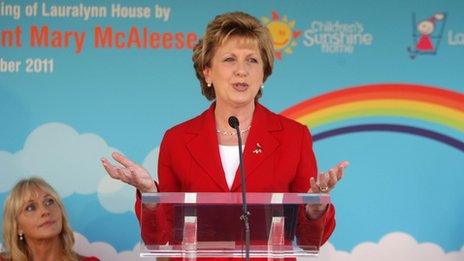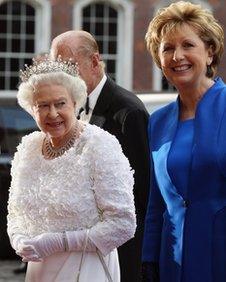The highs and lows of Mary McAleese's presidency
- Published

Mary McAleese is widely believed to be a tough act for her successor to follow
On Thursday, voters in the Irish Republic go to the polls to elect their next president.
The post has been held by Mary McAleese for the past 14 years, and she is widely regarded to be a hard act to follow.
BBC Northern Ireland's Dublin reporter Julie Kirby looks back over some of the highs and lows of her two terms in office.
When Queen Elizabeth II stood in Dublin's Garden of Remembrance and bowed her head in honour of those who died fighting for Ireland's freedom, it marked the defining moment for many in the McAleese presidency.
It was the culmination of long years of dedicated work building bridges between all communities on the island of Ireland.
'Tribal timebomb'
It is hard to believe then that 14 years ago, when she stood for election as a Fianna Fail candidate, she was being labelled a "tribal timebomb".
In 1997, leaked documents from the Department of Foreign Affairs suggested Mary McAleese was pushing a Sinn Fein agenda.
But the strategy backfired on her opponents, according to her biographer Justine McCarthy.
"It enraged voters that just because she was from north Belfast, Catholic, a nationalist whose family suffered extensively throughout the Troubles, that she was then depicted as a so-called tribal timebomb.
"Those scare tactics actually won support for her from people who wouldn't have dreamed of voting for her up to that point."

The president and her husband Martin have won respect among unionists north of the border
'Clumsy'
So it was ironic then that the biggest controversy to engulf her presidency stemmed from comments she made on RTE radio in 2005.
The president was in Poland attending a ceremony celebrating the liberation of the Auschwitz concentration camp and talked in the interview about how children in Northern Ireland had been taught to hate Catholics in the same way as Nazis hated Jews.
The remarks provoked a storm of criticism and she later apologised saying her words had been clumsy".
The following year, at the DUP's annual conference, Reverend Ian Paisley said he didn't like the president "because she is dishonest".
He said she had shown discourtesy by refusing to enter police stations on her visits to Northern Ireland.
It was a sign of how difficult the task of bridge building was.
'She took risks'
Undeterred, Mary and Martin McAleese reached out to unionists and loyalists hosting Twelfth of July garden parties at their official residence Aras an Uachtarain, and forging a close friendship with UDA leader Jackie McDonald.
"I've never called her president, it's always been Mary, she insisted on that from day one," Mr McDonald said.
"I was at her inauguration. When she invited me, I was more worried about her than myself, but she insisted I went down. Fair play to her, she took risks."
Mr McDonald was also invited to the War Memorial Gardens in Dublin when the Queen went there to lay a wreath in honour of those who died in the Great War.
He says the Queen's visit was a magic moment and one he will never forget.

Mary McAleese's presidency will always be remembered for the Queen's first visit to Ireland
'Cheerled boom'
While Justine McCarthy agrees it was an undeniable high point - the journalist is critical of the easy time the president has been given by the Irish media.
"The Queen's visit will survive forever in relation to the McAleese presidency. Unfortunately she was the president from the beginning of the Celtic Tiger until the end and thereafter. She cheerled the economic boom.
"She never raised a flag and said hold on - we are losing the run of ourselves. Where are our values? - that's the biggest indictment on her presidency."
For many though, like former Fianna Fail deputy deader Mary O'Rourke, Mary McAleese will simply be remembered with great affection, as one of the best presidents and a hard act to follow.
"I just think she overwhelmed us with her sagacity and know-how and the way she could carry it off," she said.
"Not fussy but perfect in the role. So I think she's ending on such a high note. I don't know what she's going to do now - but she will miss it and we will miss her, so much."